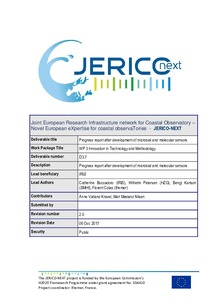| dc.contributor.author | Boccadoro, Catherine | |
| dc.contributor.author | Petersen, Wilhelm | |
| dc.contributor.author | Karlson, Bengt | |
| dc.contributor.author | Colas, Florent | |
| dc.date.accessioned | 2019-01-11T23:56:37Z | |
| dc.date.available | 2019-01-11T23:56:37Z | |
| dc.date.issued | 2017 | |
| dc.identifier.citation | Boccadoro, C.; Petersen, W.; Karlson, B. and Colas, F. (2017) Progress report after development of microbial and molecular sensors. WP3, D3.7. Revision 2.0. IFREMER for JERICO-NEXT, 46pp. (JERICO-NEXT-WP3-D3.7-4 Oct. 2017-V2.0) | en_US |
| dc.identifier.uri | http://hdl.handle.net/11329/663 | |
| dc.identifier.uri | http://dx.doi.org/10.25607/OBP-221 | |
| dc.description.abstract | The aim of Task 3.4 is to develop and test innovative methods for the molecular detection of
phytoplankton, harmful algal blooms and pollutants through their effect on microbial communities. This
will include the development of novel molecular sensors for the detection, quantification and identification
of organisms, microbial markers of pollutant exposure or toxin concentrations in marine coastal waters.
Bacterial species and genes which can be used as markers of high nutrient load or hydrocarbon
contamination in the marine environment were identified through bacterial community analysis in
contaminated environment and literature reviews. Assays using quantitative Polymerase Chain Reaction
(qPCR) for the quantification of these organisms were developed and tested through environmental
sampling campaigns and laboratory exposure studies. The most promising markers and assays were
selected for further study in conjunction with other biological and chemical sensors, and will be further
tested through campaigns to be performed through WP4.
Complementary technologies are being developed through this task to monitor toxic algae, combining an
approach based on the detection of the organisms through an autonomous sensor, and the detection of
toxins using a probe. The fully automated sensor module for autonomous monitoring of toxic algae
includes a remote-controlled automated filtration system coupled to a semi-automated nucleic acid
biosensor based on the specific binding of a molecular. This sensor will be adapted and optimised for
long term unattended operation on Ferrybox systems through this task. In parallel, for the direct detection
of algae toxins, the capabilities of an in situ optical biosensor were extended. This was done to reduce
the device size, increase its efficiency, and potentially extend its performance to detect more than domoic
acid, which was the toxin that the sensor was initially designed for. In this first phase of the project, the
sensor was successfully redesigned and is planned to be tested in laboratory conditions prior to
deployment at sea.
For investigating plankton diversity and harmful algal blooms rDNA meta barcoding methods were
developed and evaluated by analyzing samples collected using a Ferrybox system in the Baltic Sea area.
Results based on 16S and 18S rDNA show that metabarcoding reveals a much higher diversity in
phytoplankton compared to microscopy. However, metabarcoding only gives results on relative
abundance of genes (OTU, Operational Taxonomical Units) in samples and does not give information
about biomass. Microscopy gives cell numbers and biomass based on cell volumes. The two different
approaches complement each other. Metabarcoding is being further evaluated through comparison with
in situ imaging flow cytometry and microscopy in a study of harmful algal blooms on the Swedish
Skagerrak coast.
This progress report includes the work performed during the first two years of the project. During
this first phase of the project, much of the focus has been on the development and improvements
of the different types of sensors and biosensors before the sensor testing through laboratory and
field campains, which will involve sensor tests in a common setting and integration of the results
and responses from the different devices and tools. | en_US |
| dc.language.iso | en | en_US |
| dc.publisher | IFREMER for JERICO-NEXT | en_US |
| dc.relation.ispartofseries | JERICO-NEXT-WP3-D3.7-4 Oct. 2017-V2.0; | |
| dc.subject.other | Sensors | en_US |
| dc.title | Progress report after development of microbial and molecular sensors. WP3, D3.7, Version 2.0. | en_US |
| dc.type | Report | en_US |
| dc.description.status | Published | en_US |
| dc.format.pages | 46pp. | en_US |
| dc.description.refereed | Refereed | en_US |
| dc.subject.parameterDiscipline | Parameter Discipline::Biological oceanography::Microzooplankton | en_US |
| dc.subject.parameterDiscipline | Parameter Discipline::Biological oceanography::Phytoplankton | en_US |
| dc.subject.parameterDiscipline | Parameter Discipline::Biological oceanography::Zooplankton | en_US |
| dc.subject.parameterDiscipline | Parameter Discipline::Biological oceanography::Bacteria and viruses | en_US |
| dc.description.currentstatus | Current | en_US |
| dc.description.sdg | 14.2 | en_US |
| dc.description.eov | Phytoplankton biomass and diversity | en_US |
| dc.description.eov | Zooplankton biomass and diversity | en_US |
| dc.description.bptype | Guide | en_US |
| obps.resourceurl.publisher | http://www.jerico-ri.eu/download/jerico-next-deliverables/JERICO-NEXT-Deliverable_3.7_v9%20.pdf | en_US |
 Repository of community practices in Ocean Research, Applications and Data/Information Management
Repository of community practices in Ocean Research, Applications and Data/Information Management
